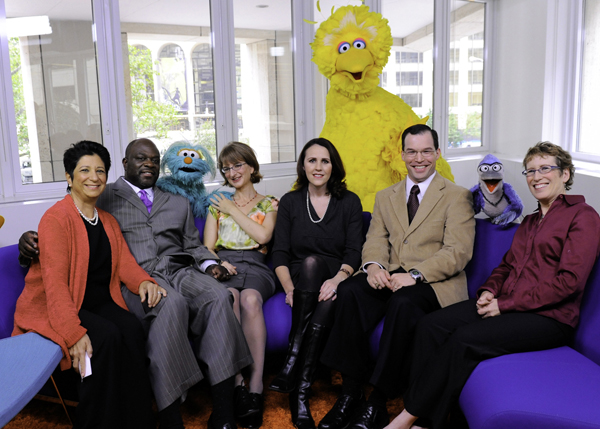Mia Doces lives and works by the “walk a mile in someone else's shoes” idiom. Turns out there’s a fair amount of perspective taking that comes with developing classroom tools that teach empathy and social-emotional learning (SEL) skills—but that comes as no surprise to the Director of New Mission Ventures at Committee for Children.
FableVision has partnered with Committee for Children on the award-winning ParkPals: Kindness Rules game, which teaches SEL and anti-bullying skills like fair play, responsibility, safety, and respect for 2nd and 3rd graders. As a former classroom educator, Mia has brought her expertise and experience to a number of like-minded environments and organizations such as Sesame Workshop and the Born This Way Foundation.
“For every product I’ve developed I put myself in the shoes of the users and imagine how the tool or the curriculum or the program is both helping kids and also making a teacher’s life easier,” Mia explains. “That’s always the starting place, but of course we test in classrooms because they are dynamic and unpredictable.”
Walk a mile in Mia’s shoes to learn more her adventures—from Committee for Children’s mission-driven work to hunting for the latest edtech tools and innovation, to traversing across America to find delectable donuts, to her riveting tales of bulls and carnivals in the rugged, rainforested land of Costa Rica.
Committee for Children's Second Step program suite of resources
Committee for Children is a global non-profit dedicated to fostering the safety and well-being of children. Tell us more about the organization’s guiding principles.
Committee for Children’s mission is to foster the safety and well-being of children through social and emotional learning and development. We do that through both advocacy and education. The core work of the organization is to develop and disseminate evidence-based, social-emotional learning programs that are fun and engaging for young people and easy for educators to implement. The programs are developmentally specific to grade level and are aligned with best practice pedagogy.
You currently explore new avenues for broadening Committee for Children’s mission impact as the Director of New Mission Ventures. What does that role entail?
I spend a good deal of time out in the field talking and listening. I look for organizations and individuals who are taking innovative approaches to improving outcomes for kids and families. I look for opportunities to partner with others to help address unmet needs, especially when it comes to underserved populations. I consider how emerging technologies, like VR for example, might enhance or harm young people’s ability to learn empathy and social skills.
Then, the NMV team explores and experiments with new ideas—seeking to test hypotheses and continuing to iterate as proof of concept advances. In some cases, those hypotheses turn into actual products that our teams develop.
Mia Doces on the Anti-Bullying Panel at Sesame Workshop
You’ve been in the education space for a long time, first as an educator, then working with Committee for Children. How has your teaching experience informed the work that you do?
I know first-hand how demanding and difficult—and rewarding!—it is to be an educator. Sometimes you imagine something, say a lesson, working one way and you try it out in a real classroom and realize you hadn’t accounted for one factor or another and it turns out completely differently than what you’d expected. There’s so much iteration and retesting that needs to happen. Having been an educator really helps with the notion that even in the workplace you need to constantly be a learner.
As technology continues to expand, how do you see digital tools boosting social and emotional skills in teaching and learning?
I think digital tools are most effective when they support and scaffold adult-child interactions, especially when it comes to teaching and learning SEL skills. Most adults do not necessarily feel like “experts” in the field of social and emotional learning. We make curricula and tools that are simple and fun to implement, allowing the adults to really learn alongside the children. Among the many goals of our programs are sparking relevant conversations, helping adults provide “in the moment” scaffolding to children as they work through challenges and creating a structure for skill practicing in a supported environment.
You were a key member in bringing the Second Step program to life. How does Second Step support and optimize SEL learning to improve student outcomes?
Second Step is a multi-component, research-based social and emotional skill-building program. The unique lessons at every grade level are carefully created and presented in an order that helps students build skills over the course of the school year. The elementary school program begins with a unit called Skills for Learning, in which children learn about and practice skills and strategies for becoming great learners. The activities are based in neuroscience, building executive function capacity via games and reflections. Then, children build skills in empathy and compassion, practicing skills like perspective taking and offering help. As the program progresses, students learn skills in recognizing emotions, regulating strong feelings, friendship-making, social problems solving, and a host of other skills and competencies that are integral for success in school and in life.
In addition to student-facing lessons, there are many resources for teachers, counselors, administrators and parents that give them the tools they need to support a child’s social and emotional growth.
How did Committee for Children come to cross paths with FableVision?
I met Gary Goldberger at a Serious Play conference a few years ago. We were excited to discover we had worked with a number of the same colleagues on aligned projects. Gary has great energy and humor in addition to deep roots in children’s media, so I knew he and FableVision would be great thought and work partners.
Studies show that mindfulness in the classroom can help create a happy, calm, and positive culture. How did you come up with the concept for Mind Yeti?
For years we’ve known about the benefits of a mindfulness practice for adults. But the research about the benefits of mindfulness for children was still nascent, albeit encouraging. We saw an opportunity to not only enrich the Second Step experience in the classroom by strengthening attention and calming skills through mindfulness exercises, but we also saw an opportunity to create a product that could easily bridge the home-school divide.
We designed Mind Yeti to be as easy to use and effective in the home as well as the classroom. To do this, we knew we wanted to create a light narrative that would both engage children and help them understand some of the fundamental components and benefits of mindfulness exercises. We did a lot of testing with young people to help guide our creation of the Yeti character, Yeti’s world and the Hubbubbles. The audio sessions include a diversity of voices and everyday sounds that help them feel interesting and familiar to kids. We have a saying that we strive to go “beyond the gong” and really make this experience relevant to the lives of today’s youth.
Are there new projects on Committee for Children’s horizon that you’re excited about?
There are so many! But one I’m particularly excited about is an experiment we’re doing within a Minecraft multi-player space. We’ve partnered with Connected Camps (Katie Salen and Mimi Ito) to explore how SEL content might be embedded in virtual environments. Situated within the social space of a Minecraft server, the peer-mediation program explores ways in which kids can develop problem-solving skills in the face of authentic and naturally arising conflict. The server allows many kids to play together in a shared virtual space, providing a framework for conflict resolution and communication tools. The program will pair SEL-infused online moderation strategies with a scaffolded conflict resolution program. It is being designed for middle school youth participating in afterschool programs.
We hear that you are quite a voracious traveler. Tell us an adventure story from your travels!
Recently, I was in the Arenal region of Costa Rica. When I travel I like to find events or activities that the locals enjoy, so when I heard a traveling rodeo was in the nearby town and that it was a big deal for locals, I had to go. When we got there, we found a rickety arena set up with lots of families in the stands, kids climbing all over the structure and, in the middle of the arena, there was a large group of children playing typical carnival games—wheelbarrow races, three legged races, etc. We thought it was a bit strange that an entire arena was set up for spectators to watch this. Until…they let out the bull. On the children.
Before we really realized what was happening we found ourselves watching a large group of children practicing what could only be described as rodeo clown training; taking turns trying to touch the bull or running wilding around it, attempting (not always successfully) to not get trampled. For the only two Americans in the crowd, the spectacle was terrifying—No helmets! No pads! But for the locals it was terribly exciting. And best of all—no one was seriously hurt!
Speaking of travels, rumor has it that you’re a foodie. What are some of your favorite spots to chow down in your hometown of Seattle, Washington…and around the globe?
I do have a notorious sweet tooth, so a 1 a.m. Voodoo Donut in Austin, Texas with Gary Goldberger and crew is always a delight! If you’re visiting Seattle and you’re a foodie, you’re in for a treat! There are so many great restaurants to choose from! If you’re looking for great NW seafood in fun locations try:
- Westward (Lake Union)
- The Walrus and the Carpenter (trendy Ballard)
- Taylor Shellfish (near the Seattle Center).
Spotlight on ParkPals: Kindness Rules
with Rachel Kamb, Senior Program Developer
at Committee for Children
What was your experience like working with FableVision on ParkPals: Kindness Rules?
It was great to collaborate with such an experienced team. At Committee for Children, our primary focus is on teaching social-emotional learning skills and concepts to students in the classroom. A game-based product is a new approach for us. Bringing their expertise together with ours was a fun and creative process.
With a focus on bullying prevention, how does ParkPals aim to create a safe and supportive environment for kids
ParkPals was designed to focus on the behaviors and attitudes that prevent bullying from happening: respect, responsibility, fairness, and safety. These behaviors and attitudes support a positive social climate. Creating a positive social climate helps children feel safer and sets the expectation that they will treat each other with respect. It can reduce the likelihood of bullying and help students feel more comfortable reporting bullying if it happens. ParkPals is a virtual playground where children can practice these skills that contribute to a safe environment in safe space.
Join us for a discussion on
digital learning and SEL tools at ISTE!
Hear more from the ParkPals development team! Join FableVision and Committee for Children in San Antonio at ISTE for a session on fostering empathetic learning experiences in the classroom and at home. Committee for Children’s Rachel Kamb and FableVision’s Gary Goldberger and Leigh Hallisey will share insights on merging content with gaming to develop social-emotional competencies and reduce bullying.
What: Empathy Empowers: Digital Learning Strategies
When: Wednesday, June 28, 1 p.m. in San Antonio, TX
Click here for more session info!






